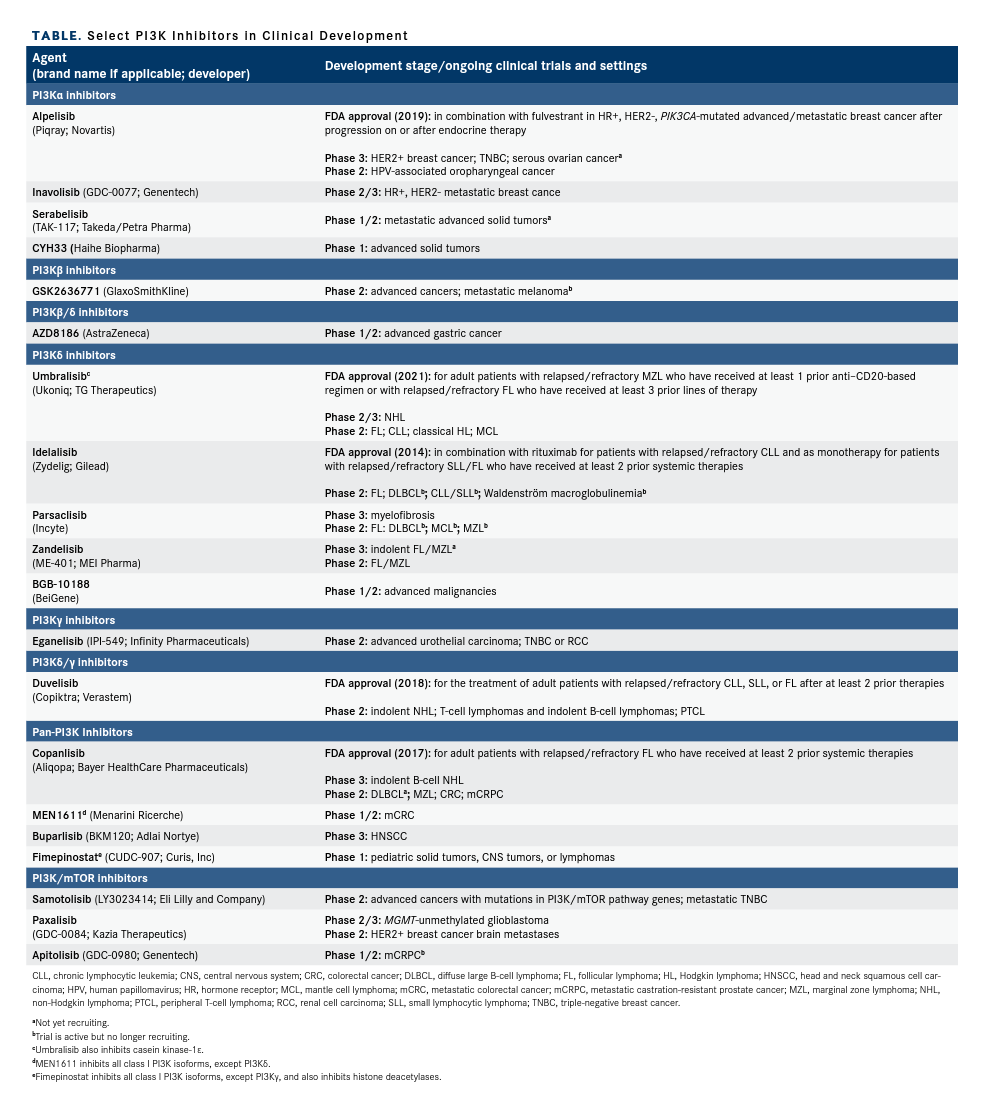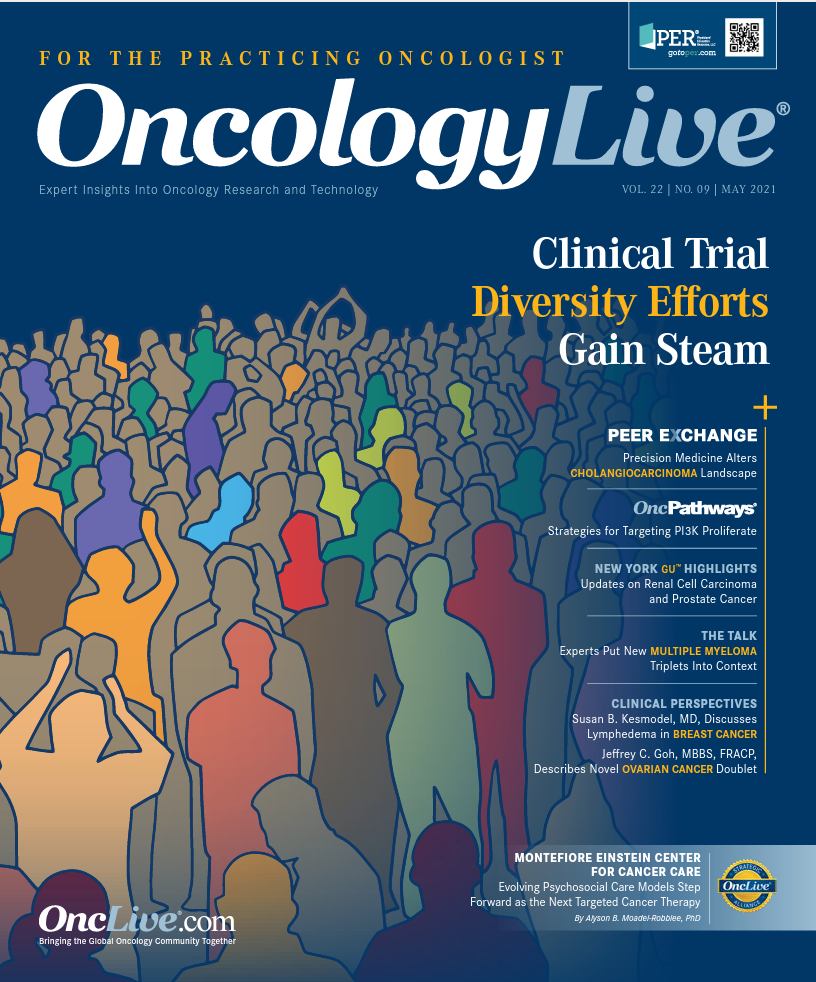Strategies for Targeting PI3K Proliferate
Frequently dysregulated in cancer cells, the PI3K pathway has long been a high-priority therapeutic target in oncology. However, initial efforts with pan–class I PI3K inhibitors were hampered by disappointing efficacy and substantial toxicity.

Frequently dysregulared in cancer cells, the PI3K pathway has long been a high-priority therapeutic target in oncology.1 However, initial efforts with pan–class I PI3K inhibitors were hampered by disappointing efficacy and substantial toxicity.2,3
The shift to isoform-specific inhibitors yielded more success, with several PI3Kδ inhibitors and the first PI3Kα inhibitor, alpelisib (Piqray), now approved by the FDA.4-6 The most recent addition to the armamentarium, umbralisib (Ukoniq), is a dual inhibitor of PI3Kδ and casein kinase-1ε (CK1ε). With umbralisib approved by the FDA in February for the treatment of relapsed/refractory marginal zone lymphoma (MZL) and follicular lymphoma (FL),7 TG Therapeutics, Inc has also filed for approval of the agent combined with the company’s anti-CD20 antibody, ublituximab, to treat patients with chronic lymphocytic leukemia (CLL) based on topline data from the UNITY-CLL trial.8,9
A host of other PI3K inhibitors designed to further improve the safety and efficacy of this drug class are being evaluated in clinical trials (TABLE). Meanwhile, indications for PI3K inhibitors could soon expand beyond B-cell malignancies and breast cancer, with promising signals from the development of the PI3Kγ inhibitor eganelisib (IPI-549) in combination with nivolumab (Opdivo) for the treatment of patients with metastatic urothelial carcinoma.10,11
TABLE. Select PI3K Inhibitors in Clinical Development

Toxicity Hampers Early Efforts
Although initial efforts to develop inhibitors targeting all of the class I PI3K isoforms were largely abandoned,2,3 copanlisib (Aliqopa) has emerged as a notable exception. In 2017, the FDA approved the kinase inhibitor for the treatment of adult patients with relapsed/ refractory FL in the third-line setting.12 Although copanlisib is described as a panclass I PI3K inhibitor, it most potently inhibits PI3Kα and PI3Kδ.13
Several other pan–class I PI3K inhibitors are still in development. Buparlisib (BKM120) has been studied extensively in several tumor types, including breast cancer, culminating in the phase 3 BELLE-3 trial (NCT01633060). In BELLE-3, the combination of buparlisib plus fulvestrant (Faslodex) demonstrated improved progression-free survival (PFS) compared with placebo plus fulvestrant, but at the expense of substantial toxicity that precluded further development in this setting.14,15
Worldwide development and commercialization rights for buparlisib were transferred from Novartis to the Chinese firm Adlai Nortye in July 2018.15 Buparlisib demonstrated promise in combination with paclitaxel for the treatment of platinum-refractory recurrent or metastatic head and neck squamous cell carcinoma (HNSCC) in the phase 2 BERIL-1 study (NCT01852292),16 and Adlai Nortye has initiated the phase 3 BURAN trial (NCT04338399) of this combination in patients with HNSCC that progressed after prior platinum-based chemotherapy with or without prior PD-1/PD-L1 inhibitor treatment.
Other early efforts focused on dual inhibitors of PI3K (pan–class I) and its downstream target mTOR; these drugs largely suffered a fate similar to that of pan–class I inhibitors.17 Several continue to be evaluated in clinical trials, however; notable among them is the oral PI3K/mTOR inhibitor paxalisib (GDC0084). Most current clinical trials of this agent, which penetrates the blood-brain barrier, are in brain cancer; PI3K pathway upregulation has been demonstrated in 85% of glioblastoma cases.18,19
Paxalisib is being evaluated in patients with newly diagnosed glioblastoma and unmethylated MGMT promoter status in an ongoing phase 2 trial (NCT03522298). Results of an interim analysis showed a median PFS of 8.4 months and overall survival of 17.5 months among 24 patients treated at the maximum-tolerated dose of 60 mg. The most common toxicities were rash, stomatitis, hyperglycemia, fatigue, nausea, and decreased appetite.19
Hematologic Malignancies
Attention in the field has largely gravitated toward isoform-specific inhibitors in the hopes of reducing off-target toxicity. Expression of the PI3Kδ and PI3Kγ isoforms is enriched in hematopoietic cells,20 leading to the pursuit of PI3Kδ/γ–specific inhibitors in patients with hematologic malignancies.
This quest culminated in the first FDA approval of a PI3K inhibitor in 2014. Idelalisib (Zydelig), an oral PI3Kδ inhibitor, was approved for the treatment of patients with relapsed/refractory small lymphocytic lymphoma (SLL) and FL and in combination with the CD20-targeting antibody rituximab (Rituxan) for the treatment of patients with relapsed/refractory CLL.5 Then, in 2018, the FDA approved the oral PI3Kδ/γ inhibitor duvelisib (Copiktra) for the treatment of adult patients with relapsed/refractory CLL, SLL, or FL.4
Most recently in this category, umbralisib was approved for the treatment of adult patients with relapsed/ refractory MZL who have received at least 1 prior CD20 antibody–based regimen and those with relapsed/refractory FL previously treated with at least 3 lines of systemic therapy.7
Umbralisib has a novel chemical structure, which is designed to reduce the potential for hepatotoxicity but also results in potent inhibition of CK1ε in addition to PI3Kδ. Combined inhibition of these 2 kinases has shown synergistic activity preclinically, with enhanced killing of lymphoma cells.21
FDA approval was based on the MZL and FL single-arm cohorts of the UNITY-NHL trial (NCT02793583). Patients with relapsed/ refractory MZL (n = 69), FL (n = 117), or SLL (n = 22) were treated with 800-mg once-daily umbralisib. Objective response rates (ORRs) were 49.3%, 45.3%, and 50.0% in patients with MZL, FL, and SLL, respectively, with complete responses (CRs) in 16%, 5%, and 5%.7,22
The most common any-grade adverse events (AEs) included diarrhea, nausea, and fatigue, and grade 3/4 AEs included neutropenia, diarrhea, and alanine aminotransferase/aspartate aminotransferase (ALT/AST) elevations.22
Topline data from the ongoing UNITY-CLL trial (NCT02612311) were recently presented at the 62nd American Society of Hematology (ASH) Annual Meeting and Exposition in December 2020. In this study, umbralisib in combination with the CD20-targeted anti-body ublituximab is compared against a combination of obinutuzumab (Gazyva) plus chlorambucil in patients with treatment-naïve or relapsed/refractory CLL.9
At a median follow-up of 36.7 months, the median PFS was 31.9 months (95% CI, 28.2-35.8 months) in the umbralisib/ublituximab arm vs 17.9 months (95% CI, 16.1-22.6 months) in the comparator arm (HR, 0.55; 95% CI, 0.41-0.72; P < .0001). ORR was also significantly higher in the umbralisib/ublituximab arm compared with the obinutuzumab/chlorambucil arm (P < .001), with numerical superiority in both treatment-naïve and previously treated patients. Responses were durable, with 62% of umbralisib/ublituximab responses maintained at 2 years.9
The most common grade 3/4 AEs included neutropenia and diarrhea.9 In December 2020, TG Therapeutics initiated a rolling submission of a biologics license application to the FDA seeking approval of this combination in patients with CLL.8
Among other PI3Kδ inhibitors in development, parsaclisib has more than 19,000-fold selectivity for PI3Kδ over other class I isoforms. Similar to umbralisib, it has a novel structure designed to reduce hepatotoxicity.23
Preliminary results were presented at 2020 ASH. Patients with relapsed/refractory FL, MZL, and mantle cell lymphoma (MCL) were treated, respectively, in the CITADEL-203 (NCT03126019), CITADEL-204 (NCT03144674), and CITADEL-205 (NCT03235544) studies with parsaclisib at 20 mg once daily for 8 weeks, followed by either 20 mg once weekly or 2.5 mg once daily. As of January 2020, 106 patients with FL (22 with weekly dosing, 84 with daily dosing), 99 patients with MZL (28 weekly, 71 daily), and 151 patients with MCL (43 weekly, 108 daily) had received treatment.24-27
Patients with MZL had received 1 or more prior therapies, including a CD20-targeted antibody, but had not been treated with a Bruton tyrosine kinase (BTK) inhibitor, whereas those with MCL were stratified according to prior receipt of a BTK inhibitor, such as ibrutinib (Imbruvica). ORRs were 69.8% and 54.3% in patients with FL and MZL, respectively, and 28.3% and 66.3% in patients with MZL who were previously treated with ibrutinib (n = 47) vs those who were not (n = 104).24-27
Meanwhile, MEI Pharma, Inc is developing the oral PI3Kδ inhibitor zandelisib (ME-401). In the phase 3 COASTAL study (NCT04745832), patients with indolent non-Hodgkin lymphoma are treated with zandelisib in combination with rituximab. Zandelisib was awarded fast track designation for the treatment of adult patients with relapsed/refractory FL in March 2020.28
PI3Kα Inhibitors in Breast Cancer
The PIK3CA gene, which encodes the p110α catalytic subunit of the PI3Kα isoform, is among the most commonly mutated genes in human cancer,29 including approximately 40% of patients with hormone receptor–positive, HER2-negative breast cancer, and has been shown to be a driver of resistance to endocrine therapy, the cornerstone of treatment in this cancer type.30
In May 2019, alpelisib became the first FDA-approved PI3Kα inhibitor. The agent is approved in combination with fulvestrant for the treatment of patients with hormone receptor–positive, HER2-negative, PIK3CAmutant advanced or metastatic breast cancer following progression on or after endocrine therapy.6 Approval was based on results from the phase 3 SOLAR-1 trial (NCT02437318), in which the combination prolonged PFS compared with placebo plus fulvestrant (median PFS, 11.0 months vs 5.7 months; HR, 0.65; 95% CI, 0.50-0.85; P < .001). The most common grade 3/4 AEs were hyperglycemia and rash; both were more common in the alpelisib arm.31
Alpelisib is approved only for patients with PIK3CA-mutant tumors, as determined by 1 of 3 FDA-approved companion diagnostic tests: Qiagen’s therascreen PIK3CA RGQ PCR Kit, a real-time, qualitative, single-gene polymerase chain reaction test that detects 11 mutations in the PIK3CA gene, and Foundation Medicine’s FoundationOne CDx and FoundationOne Liquid CDx, which are comprehensive genomic profiling tests that use next-generation sequencing to assess multiple genes, including PIK3CA. Qiagen’s test can be performed on both tissue and plasma, and the 2 FoundationOne tests are for tissue and plasma testing, respectively.32
In recent years, CDK inhibitors have become a new part of standard care in hormone receptor–positive, HER2-negative breast cancer. Thus, the ongoing phase 2 BYLieve trial (NCT03056755) is evaluating alpelisib in combination with fulvestrant in patients whose most recent prior treatment was a CDK4/6 inhibitor plus an aromatase inhibitor (cohort A; n = 127) or alpelisib plus letrozole in those last treated with a CDK4/6 inhibitor and fulvestrant (cohort B; n = 126). The primary end point was met in both cohorts, with 50.4% (95% CI, 41.2%-59.6%) and 46.1% (95% CI, 36.8%-55.6%), respectively, of patients alive without disease progression at 6 months. The safety profile was manageable.33,34
A number of other PI3Kα inhibitors are in development, including serabelisib (TAK117; Takeda Pharmaceutical licensed in 2019 to Petra Pharma Corporation35). Results from the dose-escalation portion of a phase 1b trial (NCT03154294) of serabelisib in combination with the TORC1/2 inhibitor sapanisertib (TAK228) and paclitaxel in patients with advanced ovarian, endometrial, or breast cancer demonstrated an ORR of 46% in 13 evaluable patients, with 2 patients achieving CRs.36
Efforts also are underway to develop drugs specifically targeting mutant forms of PI3Kα to reduce the potential for off-target toxicity. Genentech’s inavolisib (GDC-0077) is a novel oral PI3Kα inhibitor that also degrades the mutant form of the protein.37 Among 20 patients treated with escalating doses of inavolisib monotherapy in an ongoing phase 1 trial (NCT03006172) in patients with advanced PIK3CA-mutant solid tumors, the clinical benefit rate was 45%, with partial responses in 5 patients. Grade 3 and higher treatment-related AEs included hyperglycemia, lymphopenia, fatigue, nausea, weight loss, and asthenia.38
Expanding Tumor Types
Eganelisib is another notable agent in clinical development that could expand the approved uses of this drug class in the near future. An oral PI3Kγ inhibitor, eganelisib is being evaluated in combination with nivolumab in patients with metastatic urothelial carcinoma in the ongoing phase 2 MARIO-275 trial (NCT03980041).
Preliminary data showed that, among 33 patients who received nivolumab plus eganelisib, the ORR was 30.3%, compared with 25.0% in 16 patients who received nivolumab plus placebo, and the median PFS was 9.1 vs 8.0 weeks, respectively. In this patient population, low or negative tumor PD-L1 expression is generally associated with a poor response to immune checkpoint inhibitor monotherapy. The investigators noted that the eganelisib combination gave a particularly strong efficacy boost to patients with PD-L1–negative tumors, with an ORR of 26% vs 14% in the nivolumab-alone arm and a disease control rate of 57% vs 14%. Eganelisib was well tolerated at a dose of 30 mg once daily.10 The combination has been granted fast track designation in this setting.11
Eganelisib has also received a fast track designation in combination with an immune checkpoint inhibitor and chemotherapy for frontline treatment of triple-negative breast cancer.39 The combination of eganelisib, atezolizumab (Tecentriq), and nab-paclitaxel (Abraxane) is being evaluated in the ongoing phase 2 MARIO-3 trial (NCT03961698).
References
- Malard F, Huang X-J, Sim JPY. Treatment and unmet needs in steroid-refractory acute graft-versus-host disease. Leukemia. 2020;34(5):1229-1240. doi:10.1038/s41375-020-0804-2
- Kasikis S, Etra A, Levine JE. Current and emerging targeted therapies for acute graft-versus-host disease. BioDrugs. 2021;35(1):19-33. doi:10.1007/s40259-020-00454-7
- DiMaggio E. Acute graft-versus-host disease: emerging insights and updates into detection, prevention, and treatment. Pharmacotherapy. 2020;40(8):788-807. doi:10.1002/phar.2436
- Przepiorka D, Luo L, Subramaniam S, et al. FDA approval summary: ruxolitinib for treatment of steroid‐refractory acute graft‐versus‐host disease. Oncologist. 2020;25(2):e328-e334. doi:10.1634/theoncologist.2019-0627
- FDA expands ibrutinib indications to chronic GVHD. FDA. August 2, 2017. Accessed March 1, 2021. https://www.fda.gov/drugs/resources-information-approved-drugs/fda-expands-ibrutinib-indications-chronic-gvhd
- Kadmon announces U.S. FDA has extended the review period for belumosudil in chronic graft-versus-host disease. News release. Kadmon Holdings, Inc; March 10, 2021. Accessed March 30, 2021. https://investors.kadmon.com/news-releases/news-release-details/kadmon-announces-us-fda-has-extended-review-period-belumosudil
- ElsaLys Biotech announces submission of biologics license application to FDA for Leukotac (inolimomab) for the treatment of graft-versus-host disease in adult patients. News release. ElsaLys Biotech; July 23, 2020. Accessed February 26, 2021. https://www.elsalysbiotech.com/node/113
- Zeiser R, Blazar BR. Pathophysiology of chronic graft-versus-host disease and therapeutic targets. N Engl J Med. 2017;377(26):2565-2579. doi:10.1056/NEJMra1703472
- Mandanas RA, Yuen C. Graft versus host disease. Medscape. Updated January 27, 2020. Accessed March 2, 2021. https://emedicine.medscape.com/article/429037-overview
- MacDonald KPA, Hill GR, Blazar BR. Chronic graft-versus-host disease: biological insights from preclinical and clinical studies. Blood. 2017;129(1):13-21. doi:10.1182/blood-2016-06-686618
- Kumar S, Mohammadpour H, Cao X. Targeting cytokines in GVHD therapy. J Immunol Res Ther. 2017;2(1):90-99.
- Elbendary A, Kellen R. Off-label uses of biologic agents approved for psoriasis and psoriatic arthritis for dermatological conditions: part II. J Psoriasis Psoriatic Arthr. 2017;2(2):65-72. doi:10.1177/247553031700200205
- Petrolini Capobianco M, Capatti Cassiano G, da Cruz Furini AA, Moreno Storti de Melo L, Bonini Domingos CR, Dantas Machado RL. Human interleukin 2 (IL-2) promotion of immune regulation and clinical outcomes: a review. J Cytokine Biol. 2016;1:109. doi:10.4172/jcb.1000109
- Socié G, Milpied N, Yakoub-Agha I, et al. Long-term follow-up of a phase 3 clinical trial of inolimomab for the treatment of primary steroid refractory aGVHD. Blood Adv. 2019;3(2):184-186. doi:10.1182/bloodadvances.2018028282
- Socié G, Vigouroux S, Yakoub-Agha I, et al. A phase 3 randomized trial comparing inolimomab vs usual care in steroid-resistant acute GVHD. Blood. 2017;129(5):643-649. doi:10.1182/blood-2016-09-738625
- Schwartz DM, Kanno Y, Villarino A, Ward M, Gadina M, O’Shea JJ. JAK inhibition as a therapeutic strategy for immune and inflammatory diseases. Nat Rev Drug Discov. 2017;17(1):78. doi:10.1038/nrd.2017.267
- Jagasia M, Perales M-A, Schroeder MA, et al. Ruxolitinib for the treatment of steroid-refractory acute GVHD (REACH1): a multicenter, open-label phase 2 trial. Blood. 2020;135(20):1739-1749. doi:10.1182/blood.2020004823
- Zeiser R, von Bubnoff N, Butler J, et al; REACH2 Trial Group. Ruxolitinib for glucocorticoid-refractory acute graft-versus-host disease. N Engl J Med. 2020;382(19):1800-1810. doi:10.1056/NEJMoa1917635
- Zeiser R, Polverelli N, Ram R, et al. Ruxolitinib (RUX) vs best available therapy (BAT) in patients with steroid-refractory/steroid-dependent chronic graft-vs-host disease (cGVHD): primary findings from the phase 3, randomized REACH3 study. Blood. 2020;136(Suppl 1):22-24. doi:10.1182/blood-2020-137694
- Incyte announces acceptance and priority review of sNDA for Jakafi (ruxolitinib) as a treatment for patients with chronic graft-versus-host disease. News release. Incyte; February 22, 2021. Accessed March 31, 2021. https://bwnews.pr/2OfIXgI
- Zeiser R, Socié G, Schroeder MA, et al. Gravitas-301: a randomized, double-blind phase 3 study of itacitinib or placebo in combination with corticosteroids for initial treatment of patients with acute graft-versus-host disease. Presented at: 25th Annual Congress of the European Hematology Association; June 11-21, 2020; virtual. Abstract S256. Accessed March 3, 2021. https://bit.ly/3rhr0MT
- Clayton NS, Ridley AJ. Targeting Rho GTPase signaling networks in cancer. Front Cell Dev Biol. 2020;8:222. doi:10.3389/fcell.2020.00222
- Hill L, Alousi A, Kebriaei P, Mehta R, Rezvani K, Shpall E. New and emerging therapies for acute and chronic graft versus host disease. Ther Adv Hematol. 2018;9(1):21-46. doi:10.1177/2040620717741860
- Kadmon announces positive topline results of pivotal trial of belumosudil (KD025) in chronic graft-versus-host disease. News release. Kadmon Holdings, Inc; May 21, 2020. Accessed March 2, 2021. https://investors.kadmon.com/news-releases/news-release-details/kadmon-announces-positive-topline-results-pivotal-trial/
- Buch MH, Vital EM, Emery P. Abatacept in the treatment of rheumatoid arthritis. Arthr Res Ther. 2008;10 Suppl 1(Suppl 1):S5. doi:10.1186/ar2416
- Watkins B, Qayed M, McCracken C, et al. Phase II trial of costimulation blockade with abatacept for prevention of acute GVHD. J Clin Oncol. Published online January 15, 2021. doi:10.1200/JCO.20.01086
- Bristol-Myers Squibb announces U.S. FDA breakthrough therapy designation for Orencia (abatacept) to help prevent acute graft [-versus-host disease]. News release. Bristol-Myers Squibb; December 4, 2019. Accessed March 1, 2021. https://news.bms.com/news/details/2019/Bristol-Myers-Squibb-Announces-US-FDA-Breakthrough-Therapy-Designation-for-ORENCIA-abatacept-to-Help-Prevent-Acute-Graft/default.aspx
- Pipeline. Equillium Bio. Accessed February 25, 2021. https://equilliumbio.com/pipeline/
- Equillium announces positive interim data with itolizumab in acute GVHD study. News release. Equillium, Inc; August 10, 2020. Accessed February 25, 2021. http://www.globenewswire.com/news-release/2020/08/10/2075965/0/en/Equillium-Announces-Positive-Interim-Data-with-Itolizumab-in-Acute-GVHD-Study.html
- A dose-finding study of vedolizumab for treatment of steroid-refractory acute intestinal graft-versus-host disease (GvHD) in patients who have undergone allogeneic hematopoietic stem cell transplantation (Allo-HSCT). ClinicalTrials.gov. Updated May 24, 2019. Accessed March 1, 2021. https://clinicaltrials.gov/ct2/show/NCT02993783
- Chen Y-B, Shah NN, Renteria AS, et al. Vedolizumab for prevention of graft-versus-host disease after allogeneic hematopoietic stem cell transplantation. Blood Adv. 2019;3(23):4136-4146. doi:10.1182/bloodadvances.2019000893
- Kekre N, Kim HT, Hofer J, et al. Phase II trial of natalizumab with corticosteroids as initial treatment of gastrointestinal acute graft-versus-host disease. Bone Marrow Transplant. Published online September 8, 2020. doi:10.1038/s41409-020-01049-0. Published correction appears in Bone Marrow Transplant. Published online October 12, 2020.
- Jaglowski SM, Blazar BR. How ibrutinib, a B-cell malignancy drug, became an FDA-approved second-line therapy for steroid-resistant chronic GVHD. Blood Adv. 2018;2(15):2012-2019. doi:10.1182/bloodadvances.2018013060
- Miklos D, Cutler CS, Arora M, et al. Ibrutinib for chronic graft-versus-host disease after failure of prior therapy. Blood. 2017;130(21):2243-2250. doi:10.1182/blood-2017-07-793786
- Meyer EH, Hoeg R, Moroz A, et al. Orca-T, a precision Treg-engineered donor product, in myeloproliferative HLA-matched transplantation prevents acute and chronic GVHD with less immunosuppression in an early multicenter experience. Presented at: 2021 Transplantation & Cellular Therapy Meetings; February 8-12, 2021; virtual. Abstract 88.




